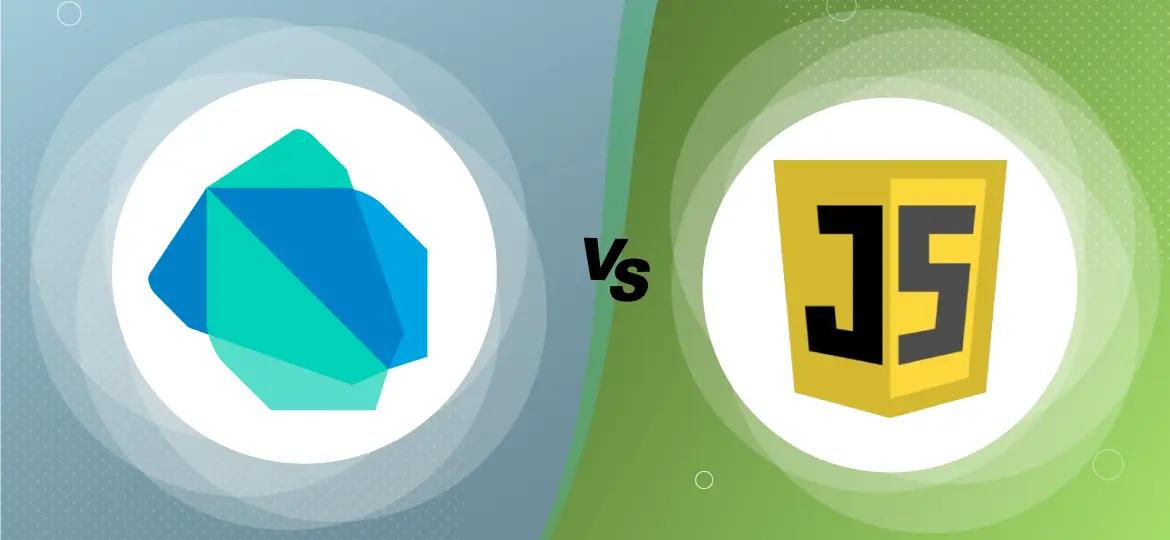In this article, we will read about Dart Vs JavaScript, two widely known languages in cross-platform mobile application development. Apart from comparing them, we’ll also study their history, level of popularity, features, advantages & disadvantages. To help you decide which platform is best, we’ll take some key parameters so that you can analyze the performance level and features of both of these platforms. So without wasting further time, let’s start this article.
What Is Dart?
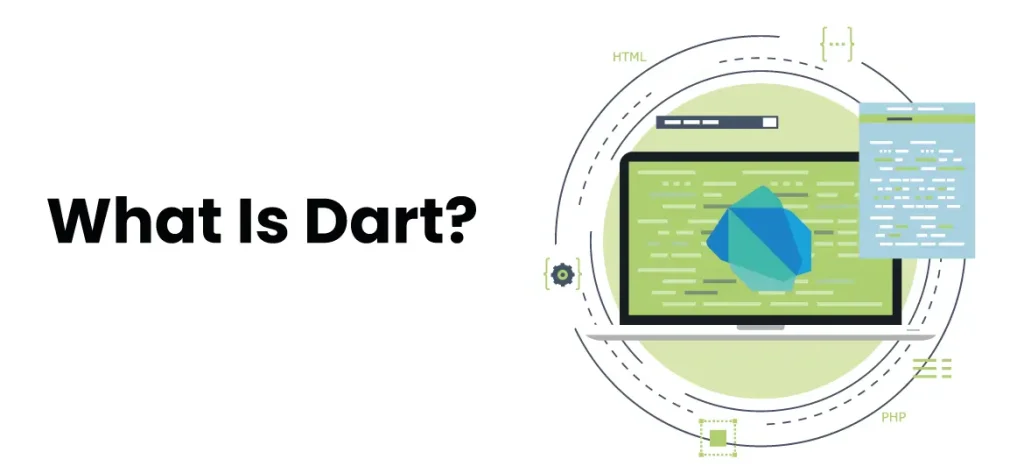
Dart is a client-driven programming language for fast app development across all platforms. The aim is to provide the most efficient programming language for cross-platform development combined with a scalable execution runtime for designing apps. A language’s technical foundation is defined by the decisions made during development. These decisions define the language’s capabilities and strengths.
Dart is built for a specific technical envelope that’s best suited for client development. Thus they prioritize high-quality production accessible on the web, mobile, & desktop. It is also the basis for Flutter. While it is the language and runtime that powers Flutter applications, it also supports many of the core developer jobs such as formatting, analysis, and testing.
History
Dart was first introduced in October 2010 at a conference held in Denmark. It was developed by a Danish Programmer named Lars Bark and Kasper Lund, a software engineer. Since Dart could be turned into JavaScript, it was sought after for its cross-browser availability. As a result, Ecma International gave strong approval to its first edition. Subsequently, Ecma International has again accepted the second version of the Dart standard in December 2014. So far Dart has progressed massively with compiling positively with mobile, desktop, and other programming languages including Javascript.
What Is JavaScript?
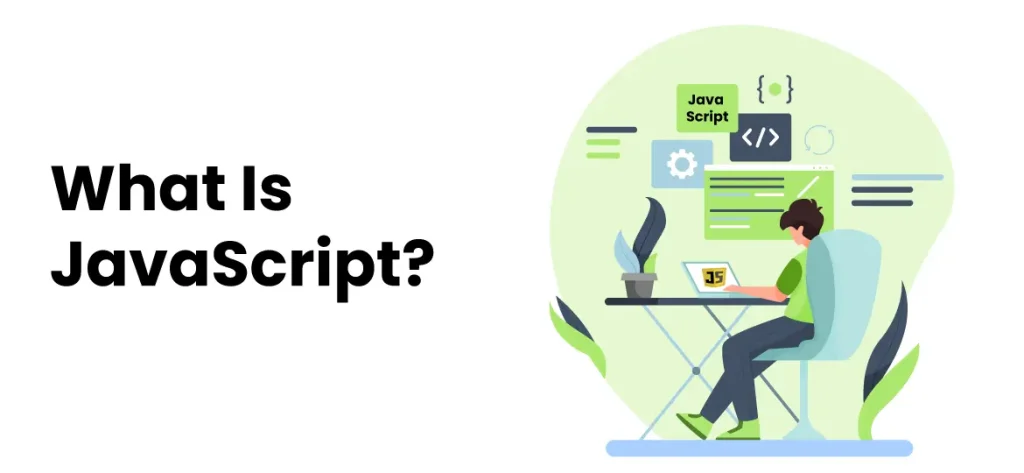
JavaScript is a popular programming language, and it is mostly used for web development. Because it makes web pages more interactive and dynamic, it’s a necessary tool for developing contemporary online apps. They are used primarily for providing web-development services to the clients but they can also be employed on the server-side using technologies like Node.js.
It allows developers to create web page content, manipulate them, respond to user actions, and communicate with servers. JavaScript code can be written directly within HTML documents using <script> tags or as separate external files with a .js extension. You can use JavaScript for creating dynamic and creative websites, building web and mobile apps, writing server-side codes, and developing video games.
History
JavaScript was created in 1995 by Brendan Eich for Netscape Navigator, the influential web browser at that time. It helped developers create visual elements on the screen for better user interaction bringing dynamic results to their websites. Over the course of the first six months, JavaScript underwent many name changes. Before being dubbed JavaScript, it was first known as Mocha, then LiveScript.
These days, JavaScript is much more than just a web scripting language. JavaScript is a powerful and flexible language that can be utilized in many different contexts. As such, it may be used for imperative programming, more object-oriented styles, functional approaches, and even event-driven models.
Dart vs JavaScript : Features
Dart Features
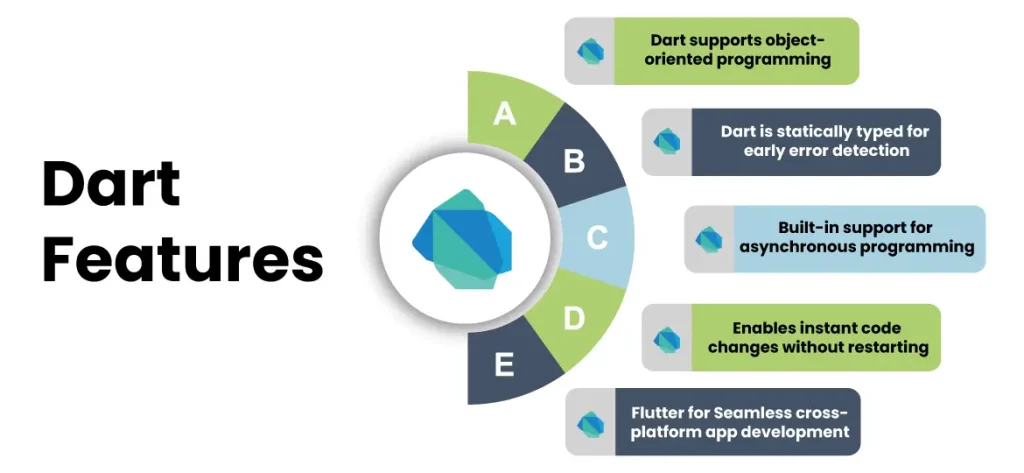
Dart Language :
Static type checking is a type safety feature of the Dart programming language, which guarantees that the value of a variable always corresponds to its static type. This is also known as sound typing at times. Type annotations are optional despite types being required due to type inference.
Additionally adaptable, the Dart typing system permits the usage of a dynamic type in conjunction with runtime checks, which might be helpful for code that has to be particularly dynamic or for experimentation.Dart has sound null safety integrated into it. Thus, unless you explicitly state otherwise, values cannot be null.
Static code analysis with good null safety allows Dart to shield you against null exceptions at runtime. When Dart finds that a variable is non-nullable, it can never be null, in contrast to many other null-safe languages. Sound null safety results from the retention of non-nullability during runtime, as can be seen when you examine your code while it’s running in the debugger.
Explore this as well
Set of Core Libraries :
Dart has a huge set of core languages to choose from. All Dart programs come with built-in types, collections, and other essential features. With more complex collection types which include binary trees, hashmaps, linked lists, and queues. Performs functions and constants in mathematics as well as the creation of random numbers.
Also supports asynchronous programming like Future and Stream Lists, which can handle SIMD numeric types and fixed-sized data effectively. It has additional I/O functionality for non-web applications, such as file, socket, and HTTP
Interfaces for foreign functions to facilitate communication with other programs that display a C-style user interface.
Platform for Running Codes :
Dart helps you in running codes through various platforms. It has Native Platform with an ahead-of-time (AOT) compiler for creating machine code as well as a Dart virtual machine (VM) with just-in-time (JIT) compilation for apps aimed at desktop and mobile platforms. Web Platform which can compile apps for development or production that are intended for the web. JavaScript is translated from Dart by its web compiler.
Flutter Toolkit :
It has a multi-platform UI toolkit powered by Dart platform which provides tools and UI libraries to build UI experiences that can run on iOS, macOS, Windows, Linux, and the web.
Dart Runtime Feature :
A Dart runtime is necessary for code execution, regardless of the platform or compilation method. This runtime is responsible for doing some important tasks like managing memories, where Dart’s managed memory architecture, a garbage collector recovers any memory that isn’t in use. It also executes Dart type system and control isolates.
Explore this as well
JavaScript Features
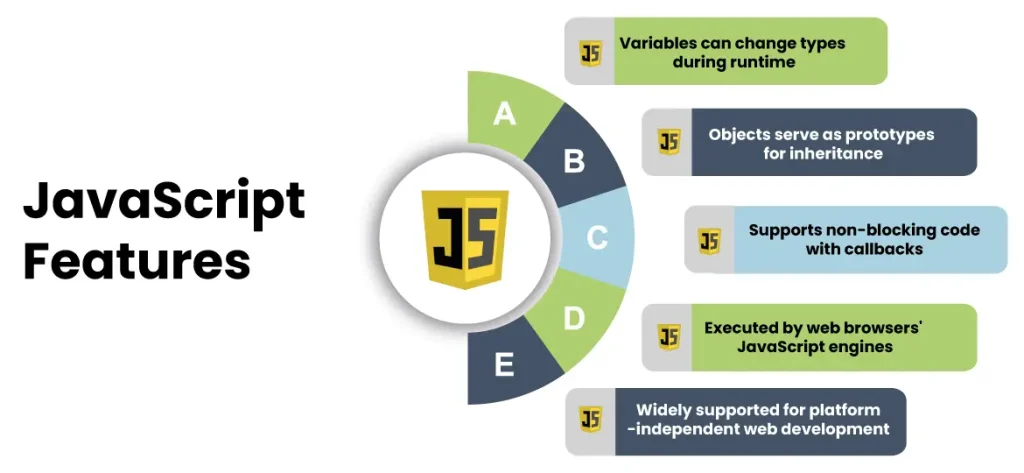
JS Language :
Javascript uses a light-weight scripting language designed in a way which clients can execute easily in their browsers. Since it primarily focuses on web applications, the set of libraries is also geared towards web applications. It can be easily interpreted, enable you to handle events and even generate custom events. Additionally, it is lightweight, case-sensitive, support dynamic typing and functional programming.
Lightweight :
JavaScript isn’t translated into byte-code beforehand because it isn’t a compiled language. It does, however, adhere to the Just-In-Time (JIT) Compilation paradigm. In other words, it is transformed to bytecode right before running. Because of this, JS can be lightweight. JavaScript can operate on devices with even lower processing power.
Case Sensitive :
It is highly case-sensitive. Thus accordingly all keywords, variables, function names and other identifiers must follow a consistent capitalization of letters. It’s important to pay attention to the case while writing JavaScript code since capitalization counts. That implies that you probably won’t receive the same results if a code is written with one character in uppercase and another in lowercase.
Higher Order Function Support :
JavaScript allows Higher Order Functions, which are functions that return another function. Simply said, functions that are treated like first-class citizens by the JavaScript interpreter behave in a manner similar to that of objects or other variables. This means that we can assign a value to a variable, return them via a different function, and pass them into arguments.
Platform Independent :
As we know, JavaScript is a cross-platform, it can function on any computer, regardless of the operating system being used. Netscape 2.0 and later comes pre-installed with JavaScript. A piece of JavaScript code will provide the same result with the same setting on all platforms because the JavaScript interpreter is a component of Netscape and operates on platforms that support Netscape.
Prototype Based Scripting Language :
JavaScript utilizes the prototype based inheritance feature rather than the more widely used class inheritance, hence it is a prototype-based scripting language. This means that we declare the object prototype and utilize this object prototype to construct more objects of the same type, rather than establishing classes and deriving objects from them. Because of the way this behavior resembles that of the object factory function, JavaScript code frequently uses this kind of design pattern.
Newly Added Features :
JS is also equipped with some uniquely built features that can be a great resource tool for developers and professional coders. Some of them are : Nullish Coalescing Operator, Logical Nullish Assignments, Styling Console Log, Object Shorthand, Optional Chaining, Defer/Async Loading, etc.
Dart vs JavaScript: Which One Is Better?
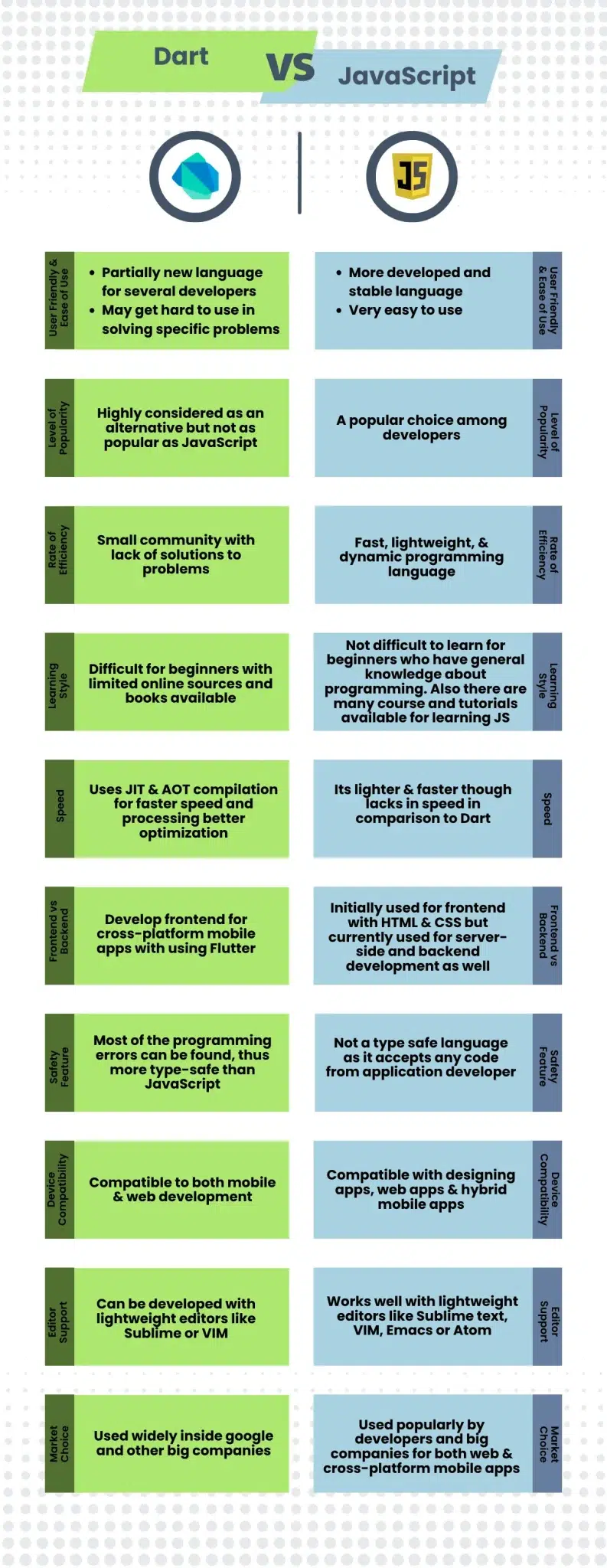
Difference Between Dart And Javascript
Dart
User Friendly & Ease of Use :
For the majority of developers outside of Google, Dart is still a relatively new language. Despite the fact that Google has worked hard to document the Dart programming language, developers still have difficulty locating answers to certain issues. Once they understand the fundamentals, developers with an OOPS background can readily comprehend and use Dart due to its Java-like syntax and coding style.
Explore this as well
Level of Popularity :
Prior to Google announcing Flutter, Dart was nonexistent. But since Flutter was unveiled at Google I/O, Dart has become much more popular among mobile developers as a React Native substitute. Dart was discovered as a substitute programming language by developers who preferred JavaScript. Dart’s popularity increased significantly as major corporations like Google, etc. adopted Flutter, although it still isn’t quite as common as JavaScript.
Rate of Efficiency :
Although Dart has excellent documentation, the capabilities of the language can be confusing to new or even seasoned developers. Because Dart’s syntax is clear and resembles Java in most cases, developers having experience with Java may pick up on it quickly. Nonetheless, developers might have a difficult time coming up with fixes for Dart’s issues.
Learning Style :
Since Dart is not a widely used programming language and there aren’t many online books or courses accessible, learning the language might be a daunting task for beginners. On the other hand, programmers from other OOPS languages can more readily grasp the fundamentals of Dart thanks to Google’s comprehensive documentation of the language on their official website. Though some of its syntax may seem strange at first, developers will quickly become accustomed to working with Dart with a little bit of practice.
Speed :
Dart can be built in two different methods: in AOT for greater optimization during the release process, and in JIT for faster development. This allows developers to construct programs in many ways. This method has been applied to the production of Flutter apps.
Frontend vs Backend :
Currently, Dart and Flutter are being utilized to construct the front end of cross-platform mobile applications. Although backend development is not mentioned, Dart can also be utilized for web development.
Safety Feature :
Both robust and loose prototyping are supported by Dart. The majority of programming problems in Dart can be discovered during compilation because it is a compiled language. Dart is more type-safe than JavaScript in that regard.
Device Compatibility :
You may use Dart for web and mobile development. Alongside the Flutter framework for creating cross-platform mobile apps, Dart gained popularity. Although it is not done often, Dart can also be used to create web applications. For those who would like to give it a try, there are several tutorials and courses available for creating web apps with Dart. Nevertheless, developers are beginning to take notice of Dart as a result of Flutter’s rapid rise in popularity. Additionally, new Dart bundles are being introduced to the market. Ultimately, the success of Flutter will determine Dart’s destiny.
Editor Support :
Although lightweight editors like Sublime or VIM can also be used to develop Dart code, the most popular integrated development environments (IDEs) for developing Dart applications, particularly Flutter apps, are Android Studio and IntelliJ IDEA, which both have the Dart plugin.
Market Choice :
Since Google created Dart, it is evident that the company uses it internally. However, other major companies, such as Alibaba, have also embraced Flutter and Dart in order to create cross-platform mobile applications. Other notable businesses that employ Dart are Blossom, WorkTrails, Whale, Mobile, and so forth.
JavaScript:
User Friendly & Ease of Use :
Since JavaScript has been in use for a longer period of time, it is a more developed and reliable language. Utilizing JavaScript is quite simple. Because there are a lot of frameworks and libraries available online, developers can quickly construct apps by utilizing pre-existing code. However, you must first have a basic understanding of programming in general before you can grasp the syntax of JavaScript.
Level of Popularity :
JavaScript is currently used everywhere. No gadget on the planet is without JavaScript installed. JavaScript frameworks are widely used by businesses to create mobile and online applications. Because JavaScript can also be used to write backends and server-side apps, an increasing number of developers have become addicted to the language throughout their professional careers.
Rate of Efficiency :
There are innumerable JavaScript frameworks available, and new ones are released into the market virtually every year. Thousands of JS packages are available online since developers must share and distribute code. The JavaScript programming language is simple for new developers to pick up and utilize; thanks to pre-existing packages and developer experience.
JavaScript increases the productivity of developers because it is a lightweight, fast, and dynamic programming language. Another reason why developers choose JavaScript over other programming languages is the ease with which common problems may be solved online. There are many libraries and frameworks for JavaScript, but they’re not all created equal. Additionally, new JavaScript frameworks are regularly introduced, which means that developers are continuously required to learn new frameworks, reducing their productivity.
Learning Style :
Although it’s not easy for non-programmers to learn JavaScript, it can be easily learned if one understands the fundamentals of programming. For developers who want to learn JavaScript, there are a ton of online tutorials and courses available.
Speed :
JavaScript may feel lighter and faster because it is an interpreted language. Compared to other compiled languages like Java, it is actually faster. But when Dart was compared to JavaScript, it was substantially faster.
Frontend vs Backend :
Originally, front-end web development using HTML and CSS made use of JavaScript. But now that the Node.js framework has become popular, JavaScript is also frequently utilized for server-side and backend programming.
Safety Feature :
JavaScript is an interpreted language, so it can enable duck typing as well as dynamic typing. JavaScript is not a type-safe language; the application developer is free to enter any code. Only at runtime may errors in programming be discovered.
Device Compatibility:
Using various frameworks, JavaScript has dominated mobile and web application development. JavaScript used to be a no-brainer when it came to creating online and mobile applications for startups and small companies, thanks to Facebook’s releases of React and React Native. Many JavaScript frameworks, like Angular and vue.js, are still readily available on the market for creating web apps, progressive web apps, and hybrid mobile apps.
Editor Support :
For developing JavaScript, there are various excellent IDEs and editors available. Although developers can utilize lightweight editors like VIM, Sublime Text, Emacs, or Atom, JavaScript doesn’t always require a full-fledged IDE. Nevertheless, some IDEs are useful for developing JavaScript applications, such as WebStorm and Visual Studio Code.
Market Choice:
Large corporations utilize JavaScript extensively for creating cross-platform mobile apps as well as web applications. Although Facebook was first to develop React and the React Native framework for internal use, many other major corporations employ JavaScript, such as Instagram, Reddit, eBay, Slack, Airbnb, and so on.
Dart vs JavaScript : Merits & Demerits
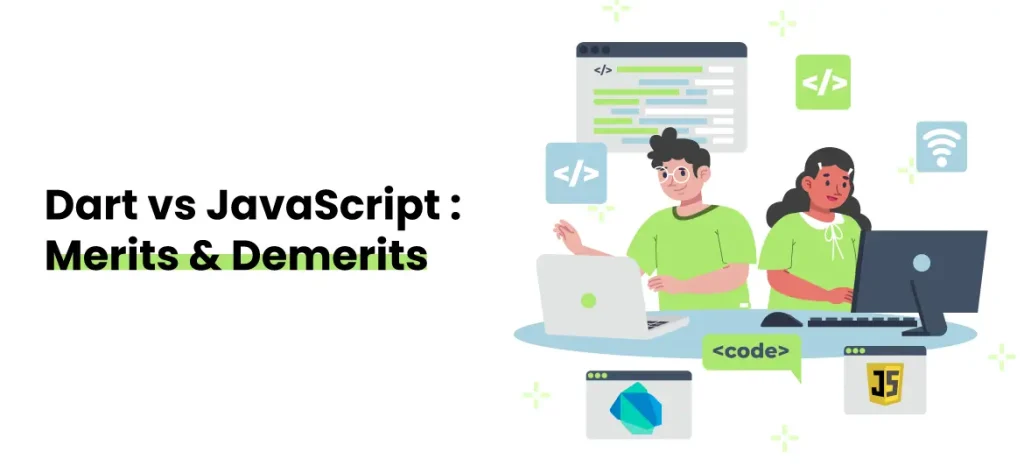
If you ask ten developers which language they prefer, they will probably all give you rather different reasons—for example, some may say they enjoy Javascript, while others might say they prefer Dart. Developers’ choice of language will undoubtedly be influenced by the demands of the project as well as their own and their team’s strengths.
When you ask experienced developers about the benefits and drawbacks of using Javascript and Dart, these are some of the most typical responses you will receive.
Explore this as well
Dart Pros And Cons
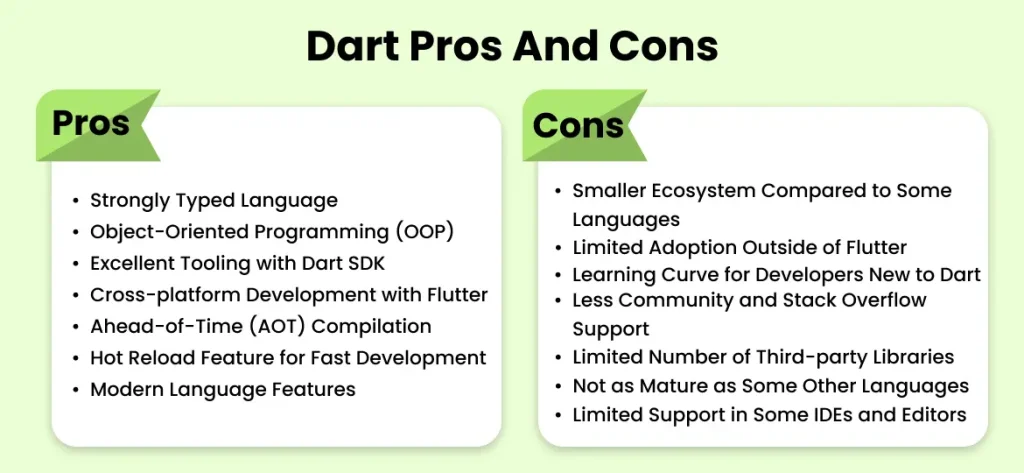
Dart Advantages
- It is an open-source software
- Operated with ease on Google Cloud Platform and has Google support
- If we estimate speed, Dart is twice times faster than JavaScript
- Dart is compatible with both AOT and JIT compilers and is type-safe
- Dart has excellent cross-project scalability.
- If you are familiar with JavaScript, learning Dart will be quite simple
- The mobile UI framework Flutter heavily relies on Dart.
Dart Disdvantages
Programmers tend to utilize Dart less frequently than other languages
Dart’s internet resources are extremely restricted, and problem-solving is challenging
There is only one object paradigm in Dart (classes)
Renaming a function in Dart requires creating a new assignment statement
JavaScript Pros And Cons
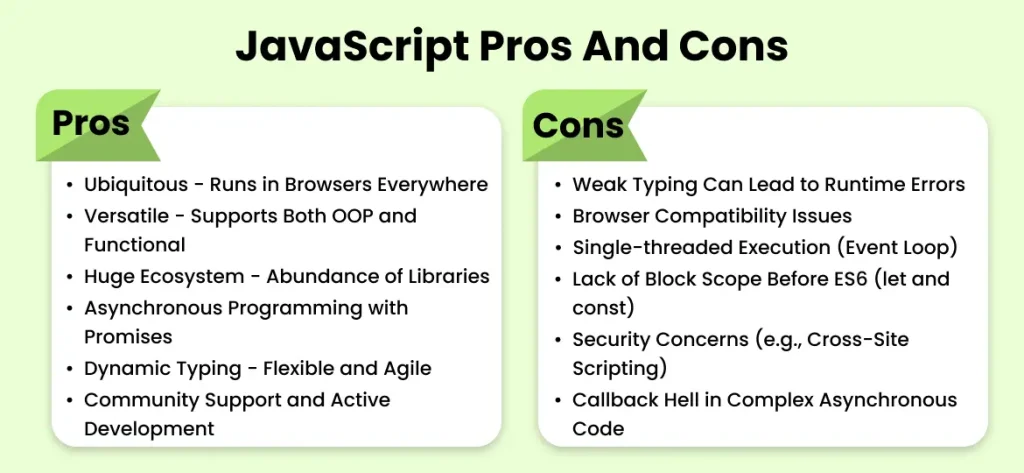
JavaScript Advantages
- JavaScript is applicable to mobile and online applications
- JavaScript can run on any device because it can be used for both frontend and backend applications
- There is a large community for JavaScript and excellent online frameworks are accessible
- Since JavaScript is extensible with other languages, it can be used in a wide variety of programs
- JavaScript is lightweight, quick, and adaptable
Explore this as well
JavaScript Disdvantages
- There are some low-quality libraries in JavaScript.
- Programmers are prone to making significant errors since the language is dynamic.
- Since new frameworks are deployed on a regular basis, there are always modifications.
- Client-side security is far from ideal.
- A single mistake can bring down an entire website.
- There is no support for multithreading.
Conclusion
With this, we’ll be ending this article on two of the most popular languages i.e. Dart Vs JavaScript. With the main focus on doing a comparative analysis between the two, we also wish to highlight their unique features and parameters upon which they are liked or taken into consideration. We hope you received knowledgeable insights between the two and received enough clarity on which programming language to choose for your upcoming projects.
We, at Echoinnovate IT, develop and design customized Web and IOS Apps with a focus on various other services like Flutter, React Native, Node JS Development & much more. Using various new technologies like Machine Learning and Artificial Intelligence, we provide the finest IT solutions at pocket-friendly prices. If you have any queries, Reach us through Echoinnovate IT or Contact us to hire our dedicated developers.
FAQs
Which language will replace Java?
Scala, a powerful programming language, seamlessly blends object-oriented and functional programming paradigms. With a concise syntax and an advanced type system, Scala provides greater expressive power compared to Java. However, its highly expressive nature, coupled with a steeper learning curve, allows developers to implement the same functionality in diverse and creative styles.
Which is faster dart or java?
Dart and Java both excel in performance, but their approaches differ. Dart boasts swift execution, leveraging its optimized runtime. On the flip side, Java’s prowess lies in its static typing, rapidly compiled bytecode, and platform versatility, requiring the JVM for execution. Each language brings its unique strengths to the performance arena.
Who uses Dart?
Dart is used by companies such as Google, CRED, SWORD Health, Mews, Colavosalon, useinsider, Modanisa.com, and On-running.com.
Who uses java?
Java is widely used across various industries and organizations. Some notable users of Java include:
- Uber
- Airbnb
- Netflix
- eBay
- Oracle (the company behind Java)
- IBM
- Amazon
